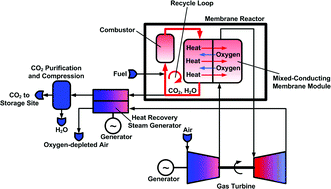This paper presents the design and part-load performance of a natural gas-fired oxy-combustion combined cycle power plant for CO2 capture. The combustion chamber of a conventional gas turbine was replaced by a membrane reactor, making it possible to obtain a highly concentrated CO2 stream for long-term storage. The focus was on power plant operation with a view to operational and material constraints of individual process components to ensure their proper performance and required lifetime. In this respect, the mixed-conducting membrane modules were of particular interest. Temperature as well as concentration limitations for CO2 and other chemical species narrowed the operating window. Other critical reactor components added further constraints. For part-load operation of the power plant, two load control strategies were analysed for the gas turbine operating at constant rotational speed. In the first load control strategy, variable guide vanes were used to manipulate the mass flow of air to the gas turbine compressor. This degree of freedom was used to control the turbine exit temperature. In the second control strategy, variable guide vanes were not used and the turbine exit temperature was allowed to vary. For both load control strategies, the mean solid-wall temperature of the membrane modules was maintained close to its design value, which led to improved stability. The load-control strategy using variable guide vanes was superior to the strategy without variable guide vanes due to higher combined cycle efficiencies and increased load-reduction capability. Moreover, the performance of the catalytic combustors in the membrane reactor, operating at near stoichiometric conditions, also improved as a result of increased oxygen concentrations at part-load operation. Relevant process components were based on spatially distributed conservation balances for energy, species, mass, and momentum. A stability diagram was incorporated into the membrane module model to investigate the risk of degradation. Performance maps were used for turbomachinery components.

You have access to this article
 Please wait while we load your content...
Something went wrong. Try again?
Please wait while we load your content...
Something went wrong. Try again?


 Please wait while we load your content...
Please wait while we load your content...